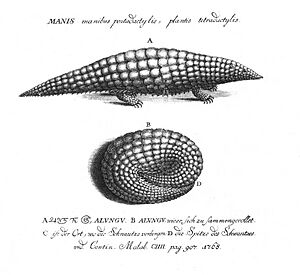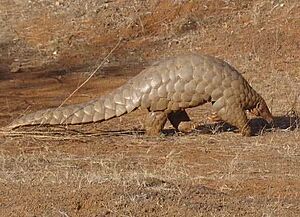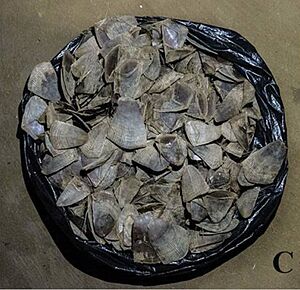Indian pangolin facts for kids
Quick facts for kids Indian pangolin |
|
|---|---|
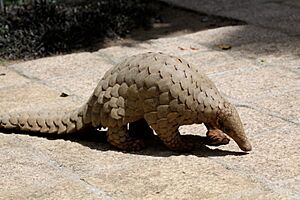 |
|
| Indian pangolin in Kandy, Sri Lanka | |
| Conservation status | |
| Scientific classification | |
| Genus: |
Manis
|
| Species: |
crassicaudata
|
The Indian pangolin (Manis crassicaudata), also known as the thick-tailed pangolin or scaly anteater, is a unique animal. It lives in the Indian subcontinent.
Like other pangolins, it has large, overlapping scales on its body. These scales act like armour. The colour of its scales changes with the colour of the soil around it. When scared, it can roll into a tight ball. This protects it from predators like the tiger.
Indian pangolins are insectivores. They mostly eat ants and termites. They dig these insects out of mounds and logs. They use their long claws, which are as long as their front legs. These animals are nocturnal, meaning they are active at night. During the day, they rest in deep burrows.
This pangolin is not common in its natural areas. It is threatened by hunting for its meat. Its body parts are also used in traditional medicine.
Contents
Meet the Indian Pangolin
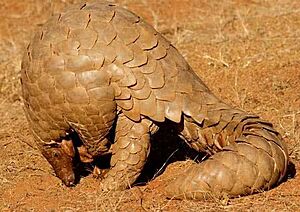
The Indian pangolin is a shy, slow-moving mammal. It lives alone and is active at night. From head to tail, it is about 84 to 122 centimetres (33 to 48 inches) long. Its tail is usually 33 to 47 cm (13 to 19 in) long. It weighs between 10 and 16 kilograms (22 to 35 pounds). Female pangolins are usually smaller than males.
This pangolin has a cone-shaped head. It has small, dark eyes and a long snout. Its nose pad is often pinkish-brown or darker. It has strong legs with sharp claws. Pangolins do not have teeth. Instead, they have strong stomach muscles to help digest their food.
The most special thing about the pangolin is its scaly armour. This covers its upper face and almost its whole body. Only its belly and the inside of its legs are not covered. These protective scales are stiff and made of keratin. A pangolin has about 160 to 200 scales. About half of these are on its tail. Each scale is about 6.5 to 7 cm (2.6 to 2.8 in) long. They are about 8.5 cm (3.3 in) wide and weigh 7 to 10 grams (0.25 to 0.35 ounces). The skin and scales make up about one-fourth to one-third of the pangolin's total weight.
Where Indian Pangolins Live
The Indian pangolin lives in many types of forests. This includes rainforests and plains in Sri Lanka. They also live in grasslands and secondary forests. They can live in dry areas and deserts too. However, they prefer hilly regions that are more barren. In Sri Lanka, they have been seen at 1,100 metres (3,600 feet) high. In the Nilgiri mountains, they were found at 2,300 metres (7,500 feet). They like soft or sandy soil. This type of soil is easy for them to dig burrows in.
Pangolin Behaviour
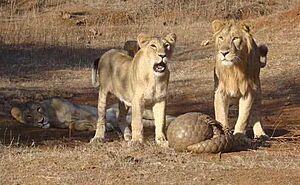
The Indian pangolin is a nocturnal animal. This means it is active mostly at night. It moves around between 5 PM and 5 AM. They are most active between 8 PM and 9 PM. This can vary a bit for each pangolin.
Indian pangolins do not climb trees. But they like to have trees, herbs, and shrubs in their home. It is easier for them to dig burrows near these plants. Pangolin habitats often have lots of ants and termites. This is because of things like grasses, bare ground, tree bases, and leaf litter.
Pangolins dig two kinds of burrows. There are feeding burrows and living burrows. Feeding burrows are smaller. Their size depends on how many insects are around. Pangolins dig more feeding burrows in spring. This is when there is more food. Living burrows are wider, deeper, and more round. Pangolins stay in these burrows longer. They use them mainly to sleep and rest during the day. After a few months, a pangolin will leave a burrow. It will then dig a new one closer to food. Sometimes, a pangolin might go back to an old burrow.
What Indian Pangolins Eat
The Indian pangolin is an insectivore. This means it eats almost only insects. It mainly eats ants and termites. It catches them with its long, sticky tongue. It is specially made to eat ants and termites. But it also looks for beetles and cockroaches. It eats the eggs, young, and adult insects. Eggs are its favourite. In the Potohar region, its diet was mostly two types of ants. These were Camponotus confuci and Camponotus compressus.
Pangolins also eat small amounts of plants, stones, sand, and clay. These help their strong stomach muscles break down food. The Indian pangolin uses its excellent sense of smell. This helps it find ant nests or termite mounds at night. They mostly look for food on the ground. But they might also eat ants from trees. This has been seen in the rainforests of Sri Lanka. Pangolins tear apart and dig into mounds. They use the three middle claws on their front feet. They throw loose soil backwards with their back feet. When eating, the pangolin quickly sticks its tongue in and out. This helps it catch its prey. This movement is also used for drinking water.
Reproduction and Life Cycle
We do not know much about how Indian pangolins breed. During mating season, male and female pangolins might share a burrow. They might also be active during the day. Males have testes in a fold of skin near their groin. The female's baby grows in one of her uterine horns. Pregnancy lasts about 65 to 70 days.
Usually, one baby is born at a time. But sometimes, twins have been reported. Newborn pangolins weigh 235 to 400 grams (8.3 to 14.1 ounces). They are about 30 cm (12 in) long. Baby pangolins are born with open eyes. They have soft scales with hairs sticking out between them. The mother pangolin carries her baby on her tail. If they are disturbed, the mother holds the baby against her belly. She then protects it with her tail.
Threats to Indian Pangolins
The Indian pangolin faces many dangers. It is threatened by poaching, which is illegal hunting. People hunt them for their meat and scales. These are used by local people. But they are also increasingly traded illegally around the world. Different parts of the pangolin are used for food and traditional medicine. The scales are sometimes used as an aphrodisiac. They are also made into rings or charms. Pangolin skins are used to make leather goods, like boots and shoes. Most hunting is done by nomads and trained local hunters.
Indian pangolin body parts have been illegally sent to China. This has been happening since the early 2000s. Pangolins are the most illegally traded protected mammals. Another big threat is habitat loss. This happens when their homes are destroyed, for example, by deforestation.
Protecting Indian Pangolins
The Indian pangolin is listed on CITES Appendix I. This means it has been protected since January 2017. It is also protected in all the countries where it lives.
Pangolins in Zoos
Indian pangolins have successfully had babies in several zoos. This includes the Calcutta Zoo, Oklahoma Zoo, and Nandankanan Zoological Park. Pangolins did not show big body changes during pregnancy. Babies have been born in captivity throughout the year. But no births were reported in May and June. At birth, a baby pangolin weighed 235 grams (8.3 ounces). It was 30 cm (12 in) long, with a 12.5 cm (4.9 in) tail. A three-day-old Indian pangolin at Oklahoma Zoo was 310 mm (12 in) long. Its tail was 125 mm (4.9 in) long.
Local Names for the Indian Pangolin
In different places, the Indian pangolin has many names:



